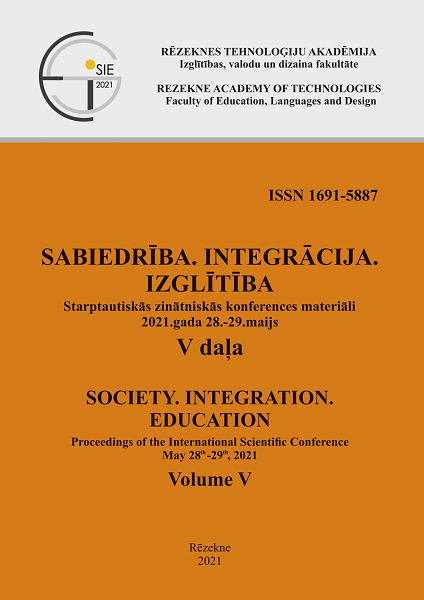USE OF DIFFERENT TECHNIQUES OF VISUALIZATIONS IN THE TRAINING OF ENGINEERING SPECIALISTS: NEEDS VERSUS APPROACHES
DOI:
https://doi.org/10.17770/sie2021vol5.6391Keywords:
Augmented Reality, Engineering graphical subjects, spatial skills, Visualization TechniquesAbstract
The quality of engineering education is closely related to the development of spatial skills of students and the ability to create and read the drawings. Visualization improves the efficiency of the information; as for visualization of geometric tasks of graphical subjects, it helps students faster comprehend complex spatial problems and solve the given exercises.
The given article describes the study of the methodology of teaching graphical subjects from the point of view of methods of representations of education materials, the degree of inspiration and engagement of students in learning activities. The research was conducted in Latvia, Lithuania, Spain, Germany and Poland within the project "Contemporary Approach to the Development of Spatial Comprehension through Augmented Reality Content" (SPACAR).
References
Anaya, A. R., Luque, M., Peinado, M. (2016). A visual recommender tool in a collaborative learning experience. Expert Systems with Applications, 45(C). DOI: 10.1016/j.eswa.2015.01.071
Auliya, R.N., & Munasiah, M. (2020). Augmented Reality Affects Students’ Attitude and Conceptual Understanding in Learning 3D Geometry. Journal Pendidikan Indonesia, 9(2). DOI: 10.23887/jpi-undiksha.v9i2.17480
Branoff, T., & Dobelis, M. (2012). The Relationship between Spatial Visualization Ability and Students' Ability to Model 3D Objects from Engineering Assembly Drawings. Engineering Design Graphics Journal of the ASEE, 76(3), 37-43.
Dobelis, M., Sroka-Bizon, M., & Branoff, T. (2019). How to Boost the Students’ Interest to Engineering Graphics? IOP Conference Series: Materials Science and Engineering. Vol.660: 4th International Conference on Innovative Materials, Structures and Technologies (IMST 2019), 1757-899X. DOI:10.1088/1757-899X/660/1/012013
Garzón, J., & Acevedo, J. (2019). Meta-analysis of the impact of Augmented Reality on students’ learning gains. Educational Research Review, 27, 244–260, Retrieved from https://doi.org/10.1016/j.edurev.2019.04.001
Klerkx, J., Verbert, K., Duval, E. (2014). Enhancing Learning with Visualization In: J. Michael (Ed), Techniques. Handbook of Research on Educational Communications and Technology (791-807), Springer Science+Business Media, New York, DOI: 10.1007/978-1-4614-3185-5_64
Martín-Gutiérrez, J., Contero, M., & Alcañiz, M. (2015). Augmented Reality to Training Spatial Skills, Procedia Computer Science, 77, 33–39, Retrieved from https://doi.org/10.1016/j.procs.2015.12.356
Ozdemir, M., Sahin, C., Arcagok, S., & Demir, M. (2018). The Effect of Augmented Reality Applications in the Learning Process: A Meta-Analysis Study. Eurasian Journal of Educational Research, 74, 165-186.
da Silva, M., Teixeira, J., Cavalcante, P., & Teichrieb, V. (2019). Perspectives on how to evaluate augmented reality technology tools for education: a systematic review. J Braz. Comput. Soc., 25(3). Retrieved from https://doi.org/10.1186/s13173-019-0084-8.
Sun, L. P., Siklander, P., & Ruokamo, H. (2019). How to trigger students’ interest in digital learning environments: A systematic literature review. Seminar.Net, 14(1), 62-84. Retrieved from https://journals.hioa.no/index.php/seminar/article/view/2597 .
Veide, Z., & Stroževa, V. (2019). Triggering the Students’ Positive Attitude for the Studies of Engineering Graphics Courses through the Augmented Reality Content. Environment. Technology. Resources: Proceedings of the 12th International Scientific and Practical Conference, 2, 242-246. DOI:10.17770/etr2019vol2.4184
Yousef, A.M.F. (2021). Augmented reality assisted learning achievement, motivation, and creativity for children of low‐grade in primary school. Journal of Computer Assisted Learning. DOI: 10.1111/jcal.12536






